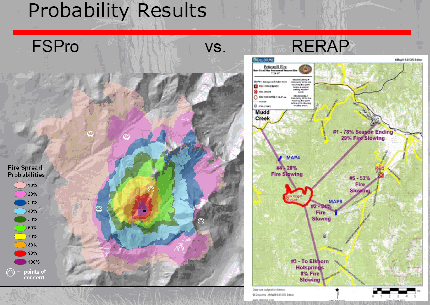Why use FSPro instead of RERAP?
Reasons for using FSPro instead of RERAP include the following:
- In a long-term analysis, we are often interested in the probability that the fire will reach or impact specific points of concern. In the example below, we have multiple points of concern intersected with an FSPro probability output for a specific time period. Each point of concern has a unique probability of being impacted during the modeled period. In contrast, the Rare Event Risk Analysis Process (RERAP) assesses only the probability of the fire reaching or impacting each point of concern individually, before the end of the season.
- RERAP assumes that the fire spread is in one direction and under the influence of a specific wind direction using the average historical climatology. By contrast, fire spread in FSPro can reach a point from any direction as a head, flanking, backing, or even a spot fire under the influence of winds from any direction. As evident in the following image, FSPro can simulate fire more realistically and account for fire spread in two dimensions under uncertain weather. Therefore, it is a better tool for probability impact analysis than RERAP.

Comparison of RERAP and FSPro Results
- RERAP does NOT account for the current season. For example, if a fire starts on June 25th, RERAP uses the historical average weather for that date. However, in FSPro, if it is an unseasonably cool year, the model uses that information based on the current year's RAWS observations. FSPro has an auto-correlation function (a way to look back), that calculates how much the future artificial seasons's ERC value depends on the recent past ERC values. However, in RERAP, it doesn't matter if it rained three inches over the past week or if it has been the hottest, driest week on record. Because FSPro uses the current season's trend, this past week's weather will affect the model's calculations.
In This Section |
See Also |
Reference |